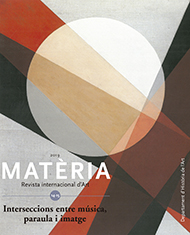Espacio, pintura y música: la capilla de Houston, Rothko, Feldman y la obra de arte total en la estética contemporánea
DOI:
https://doi.org/10.1344/Materia2019.14-15.7Paraules clau:
Rothko, Feldman, Rothko Chapel, abstracción, arte total, estética contemporáneaResum
Este artículo recorre la historia de la Rothko Chapel en Houston, como ejemplo representativo de obra de arte total en el Arte Contemporáneo. Teniendo en cuenta el significado de este concepto, se estudia la génesis de la construcción y la creación de las pinturas de Rothko. Al mismo tiempo, se analiza el momento singular y concreto en que la capilla se convierte de modo pleno en obra de arte total, cuando se interpreta aquí por primera vez la pieza musical con el mismo nombre, Rothko Chapel, compuesta por Morton Feldman como homenaje a su amigo el desaparecido Rothko a petición de los promotores de la capilla, el matrimonio de Menil. El recorrido termina con el testimonio actual del lugar como vivo punto de encuentro entre la obra de arte en sí misma, y la experiencia vital, espiritual y estética de los visitantes que a ella acuden hoy.
Referències
ARNALDO, Javier, Fragmentos para una teoría romántica del arte,Madrid, Tecnos, 1994.
ASHTON, Dore About Rothko, Nueva York, Oxford University Press, 1983.
BRESLIN, James, E. B., Mark Rothko. A Biography, Chicago, University Chicago Press, 1993.
CHAVE, Anna, Mark Rothko. Subjects in Abstraction. Yale, Yale University Press, 1989.
COUTURIER, Marie-Alain; RAYSSIGUIER, Louis-Bertrand, The Vence Chapel: The Archive of a Creation, Houston, Menil Foundation, Milán, Sikira Editore, 1999.
CUNNINGHAM, Carl, «Creating the sound of Rothko», Houston Post,7 de mayo, 1971, p. 15. [Consulta: 5 de noviembre de 2018]. Disponible en: <http://www.cnvill.net/mfcunningham.pdf>
ERICSON, Raymond, «Secular Service», New York Times, 2 de abril, 1972.
FELDMAN,MortonPensamientos verticales, Buenos Aires, Caja Negra, 2017.
GLUECK, Grace,«Mark Rothko, Artist, A Suicide Here at 66»,New York Times, 26 febrero, 1970, pp. 1 y 39.
HARRISON,Charles; WOOD, Paul, (eds.), Art in Theory. 1900-1990. An Anthology of Changing Ideas, Oxford, Blackwell Publishers, 1992.
MENIL, Dominque de, The Rothko Chapel. Writings on Art and the Threshold of the Divine,New Heaven y Londres, Yale University Press, 2010.
MENIL,Dominiquede; DUPLOYÉ, Pie, Art sacré. M. A. Couturier, Houston, Menil Foundation, 1983.
NOVALIS, Werke, (Bnd. 2), Darmstadt, Wissenschaftliche Buchgesellschaft, 1978.
NOVALIS, Fragmentos, Madrid,Instituto de Estudios Políticos, 1977.
ORTON, Fred; BRYARS, Gavin «Morton Feldman Interview», Studio International, noviembre, 1976, pp. 244-248. [consulta: 3 de diciembre de 2018].
PRETORIUS, Lesley,«Barnet Newman’s Broken Obelisk and the Rothko Chapel», De arte, vol. 27, nº 46, 1992, pp. 4-12, p. 4. doi:https://doi.org/10.1080/00043389.1992.11761147.
ROTHKO,Christopher, Rothko, from the Inside Out, New Heaven y Londres, Yale University Press, 2015.
ROTHKO, Mark La realidad del artista. Filosofía del arte, Madrid, Síntesis, 2010.
ROTHKO, Mark, Escritos sobre arte, Barcelona, Paidós, 2007.
TRAHNDORFF, Eusebius,Ästhetik oder Lehre von der Weltanschauung und Kunst, Berlín, Maurerscher Buchhandlung, 1927.
TIECK Ludwig, Franz Sternbalds Wanderungen, Stuttgart, Reclam, 2012, p. 281.
WAGNER, Richard, Arte y Revolución, Madrid, Casimiro, 2013.
WAGNER, Richard, La obra de arte del futuro, Valencia, Universidad de Valencia, 2007.
Descàrregues
Publicades
Número
Secció
Llicència
L'autor/a que publica en aquesta revista està d'acord amb els termes següents:
|  |








